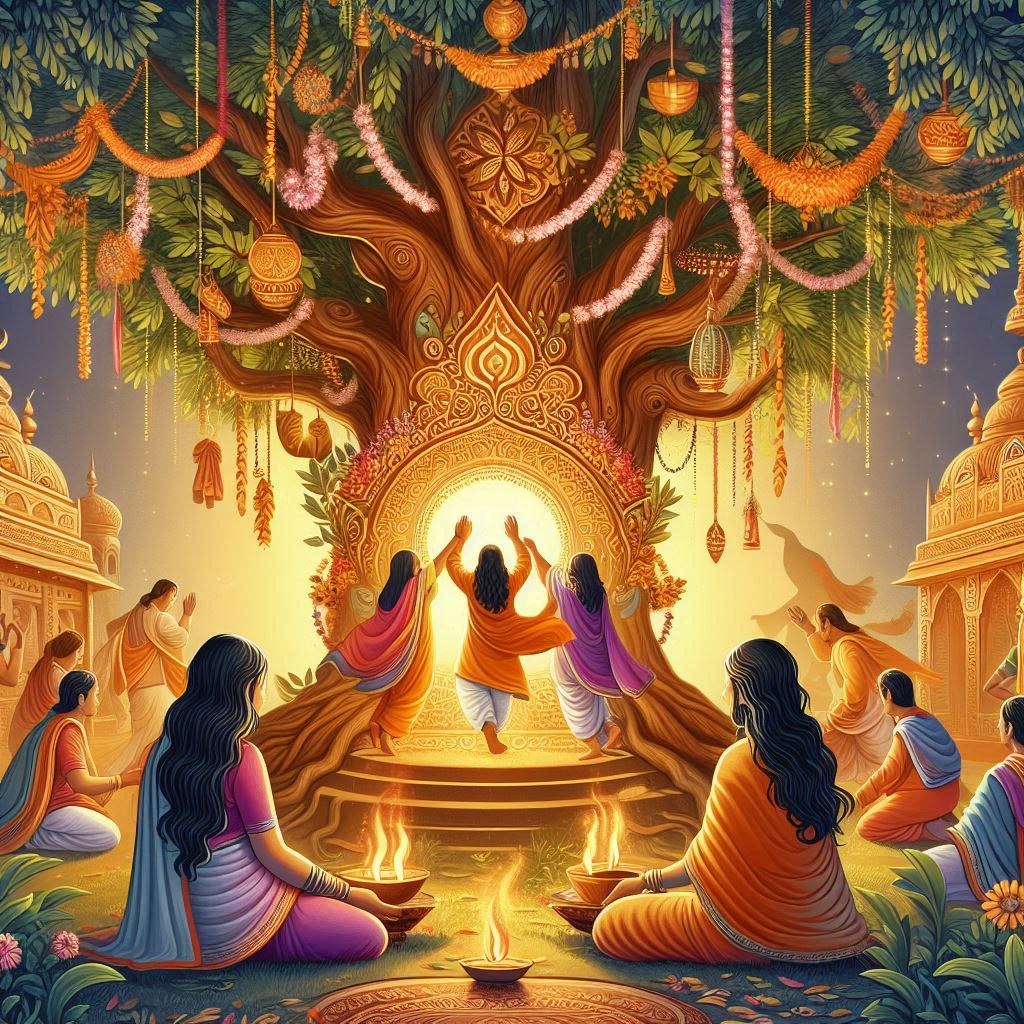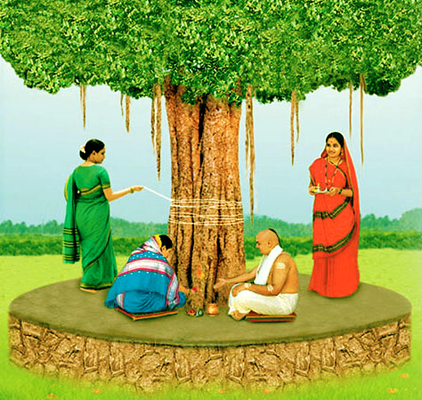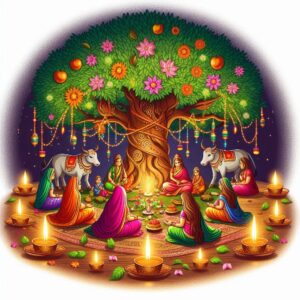🌼 Vat Savitri Vrat 🌼

॥ ॐ श्री परमात्मने नमः ॥
🚩 Vat Savitri Vrat Purnima 🚩

Significance Of Vat Savitri Vrat 2024
The event honours Devi Savitri, who forced the Lord of Death (Yama Raj) to give her deceased spouse’s life. Women offer prayers to a banyan tree on this day. Twice a year, following the Hindu lunar calendar, people hold celebrations.
According to Hindu mythology, the Vat (Banyan) tree symbolizes the “Trimurtis,” or Lord Vishnu, Lord Brahma, and Lord Shiva. People purportedly worshiping a banyan tree are considered fortunate. Numerous writings and Puranas, like the Skanda Purana, Bhavishyottara Purana, Mahabharata, etc., discuss the significance of the fast.
Hindu married women fast and perform Vat Savitri rituals to wish for their husbands’ wealth, well-being, and longevity. A married woman observes Vat Savitri Vrat to show her commitment to and genuine love for her husband.
***
Puja Time and Date of Vat Savitri Vrat (Tithi):
Vata Savitri Purnima : Friday, June 21, 2024
Vat Savitri Amavasya Vrat : Thursday, June 6, 2024
Purnima Tithi Begins : 07:31 AM on Jun 21, 2024
Purnima Tithi Ends : 06:37 AM on Jun 22, 2024
Vat Savitri Vrat 2024:
Most of the festivals in Amanta and Purnimanta lunar calendar fall on the same day. Purnimanta calendar is followed in North Indian states, mainly in Uttar Pradesh, Madhya Pradesh, Bihar, Punjab and Haryana. In the rest of the states usually Amanta lunar calendar is followed.
However, Vat Savitri Vrat could be considered as an exception. In Purnimanta calendar Vat Savitri Vrat is observed during Jyeshtha Amavasya which coincides with Shani Jayanti. In Amanta calendar Vat Savitri Vrat, which is also called Vat Purnima Vrat, is observed during Jyeshtha Purnima.
Hence married women in Maharashtra, Gujarat and southern Indian states observe Vat Savitri Vrat 15 days (about 2 weeks) later than that of North Indian women. However, the legend behind observing the fast is the same in both calendars.
According to legend great Savitri tricked Lord Yama, the lord of death, and compelled Him to return the life of her husband Satyawan. Hence Married women observe Vat Savitri Vrat for well-being and long life of their husband.
***
Rituals of Vat Savitri Vrat:

- Women take a holy bath before sunrise with Amla (Indian gooseberry) and til (sesame seeds) and get dressed in clean clothes. They apply vermillion and wear bangles — accessories synonymous with a married woman — pledging a nirjala (no water intake) fast.
- Devotees eat the roots of the Vat (Banyan) tree and if the fast lasts for three consecutive days, they consume the same with water.
- After offering prayers to the Vat tree, they tie a red or yellow colored sacred thread around its trunk.
- Women offer rice, flowers, and water to the banyan tree and perform Parikrama (take rounds) of the tree while reciting prayers.
- If a banyan tree is not available, devotees can create a portrait of the tree with the help of sandalwood paste or turmeric on a wooden base to perform the rituals in a similar way.
- Devotees are also required to prepare special dishes and sacred food on the day of Vat Savitri. Once puja concludes, prasad is distributed among all family members.
- Women also seek blessings of the elderly in their homes.
- Devotees should donate clothes, food, money and other essentials to the needy.
***
Shlokas and Mantra:
अवैधव्यं च सौभाग्यं देहि त्वं मम सुव्रते।
पुत्रान् पौत्रांश्च सौख्यं च गृहाणार्घ्यं नमोऽस्तुते।।
यथा शाखाप्रशाखाभिर्वृद्धोऽसि त्वं महीतले।
तथा पुत्रैश्च पौत्रैश्च सम्पन्नं कुरु मा सदा।।
***
Introduction To Vat Savitri Puja:

The Hindu holiday known as Vat Savitri Vrat is a unique celebration for married ladies. Another name for this celebration is Vat Amavasya. Women in relationships commemorate this holiday. The married woman creates a symbol of her love for her husband at this event by wrapping a sacred thread around a banyan tree. Savitri and Satyavan’s tale serves as the inspiration for the event. This fast, as it is depicted in the Mahabharata, has come to represent aspirational femininity in Indian culture.
There is much controversy about this fast. According to Skanda Purana and Bhavishya Purana, it is prohibited to fast on the day of the full moon in Shukla Paksha of the Jyeshtha month, however, according to Nirnayamrita and other sources, this is not the case.
The goal of this fast remains the same despite the variations in dates. Many women adhere to the belief that this fast should be observed between Trayodashi and Amavasya in the Jyeshtha month and between Trayodashi and Poornima in the Shukla Paksha. Most devotees of Lord Vishnu observe this fast on full moons.
“Vat Savitri fast” regards both “Vat” and “Savitri” as particularly significant. To the banyan, the vat is the same as the tree. Hinduism accords the banyan tree’s significant significance. The Puranas make it clear that Mahesh, Vishnu, and Brahma all reside in the vat. Savitri is revered as a historical figure in Indian culture. Savitri is another name for Saraswati and Ved Mata Gayatri.
***
Puja materials required for Vat Savitri puja:
- A vase full of water
- Raw yarn
- Maroon thread
- Roli, sindoor, Akshat
- Sweets
- Flowers, incense sticks, dhoop
- Bamboo basket and a bamboo fan
- Soaked chickpeas
***
Steps To Perform Vat Savitri Puja:
Below are the steps to be considered while performing Vat Savitri Puja:
- Take a piece of wood or a plate and apply turmeric or sandalwood paste to draw the banyan tree and worship it for the next three days.
- Observe the fast by avoiding the food and water
- Place the idol of Maa Savitri under the Banyan tree
- Women should wear bridal attire along with jewellery and vermillion on their forehead while performing Puja
- Then, offer prayers to the Banyan tree as an honour of Goddess Gauri by reciting the Vat Savitri Vrat Katha.
- Offer fresh fruits and light up incense sticks
- Sprinkle vermillion around the tree and tie a sacred thread around the tree
- Chant prayers while revolving around the tree.
- End your fast (Vrat) by consuming fruits or prasad.
***